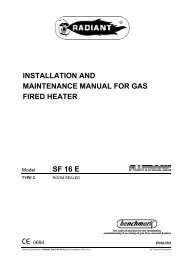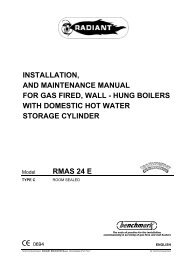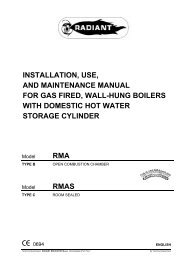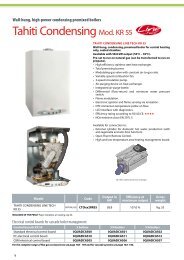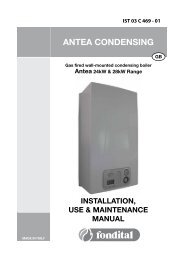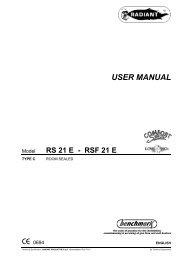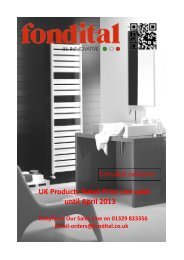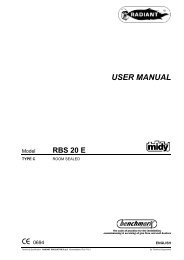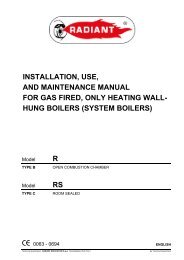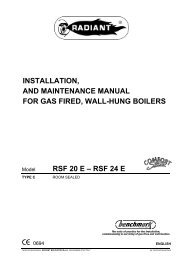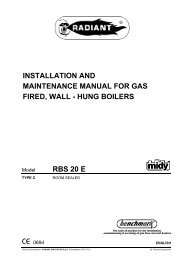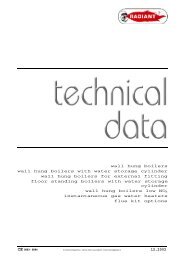TAHITI DUAL HC - HR - Portsdean Technical
TAHITI DUAL HC - HR - Portsdean Technical
TAHITI DUAL HC - HR - Portsdean Technical
You also want an ePaper? Increase the reach of your titles
YUMPU automatically turns print PDFs into web optimized ePapers that Google loves.
In order to ensure that the appliance functions correctly and efficiently, the flue connection between the boiler and the<br />
flue terminal must be made using original components specifically designed for condensing boilers.<br />
Traditional flue components cannot be used for conveying exhaust fumes from condensing boilers, nor vice versa.<br />
It is recommended that:<br />
- for the exhaust discharge duct, the entire length of the flue slopes upwards towards the exterior in order to facilitate the flow of<br />
condensate back to the combustion chamber, which has been specifically designed to collect and drain the acidic condensate;<br />
- for the air intake, the entire length of the duct slopes upwards towards the boiler to prevent the entry of rainwater, dust or foreign<br />
bodies into the pipe;<br />
in the case where a horizontal coaxial system is installed, the coaxial terminal must be positioned horizontally in that the exhaust duct<br />
has been specifically designed with the required slope (Ø 60) and the air intake (Ø 100) has been suitably protected against the weather.<br />
4.5.3. Ø 100/60 mm air/flue gas coaxial duct system<br />
Type C12<br />
The minimum permissible length of horizontal coaxial pipes is 0.5 metre, not including the first elbow connected to the boiler.<br />
The maximum permissible length of horizontal coaxial pipes is 5 metres for <strong>HC</strong>-<strong>HR</strong> 24 and 4 metres for <strong>HC</strong>-<strong>HR</strong> 32, not including the first<br />
elbow connected to the boiler. For each additional elbow, the maximum permissible length must be reduced by 1 metre.<br />
In addition, the pipe must have a 1% slope to prevent rainwater entering it.<br />
Choosing the applicable diaphragm supplied with the boiler (pic. 17)<br />
<strong>HR</strong> 24 and <strong>HC</strong> 24 <strong>HC</strong> 32 and <strong>HC</strong> 32<br />
Pipe length (m)<br />
Air intake diaphragm<br />
(mm)<br />
0,5≤ L ≤ 2 80<br />
2 ≤ L ≤ 5 82<br />
* excluding the first elbow connected to the boiler<br />
Pipe length (m) Air intake diaphragm<br />
(mm)<br />
0,5≤ L ≤ 2 87<br />
2 ≤ L ≤ 4 -<br />
* excluding the first elbow connected to the boiler<br />
0CONDASP01<br />
FROM 0,5 M TO 5 M<br />
AIR INTAKE DIAP<strong>HR</strong>AGM<br />
SEALING<br />
CAP<br />
NEOPRENE<br />
GASKET<br />
Supplied with the boiler<br />
NEOPRENE<br />
GASKET<br />
pic.17<br />
Type C32<br />
The minimum permissible length of vertical coaxial pipes is 0,5 metre, equal to the length of the chimney.<br />
The maximum permissible length of vertical coaxial pipes is 5 metres for <strong>HC</strong>-<strong>HR</strong> 24 and 4 metres for <strong>HC</strong>-<strong>HR</strong> 32, including the terminal.<br />
For each additional elbow, the maximum permissible length must be reduced by 1 metre.<br />
Choosing the applicable diaphragm supplied with the boiler (pic. 17)<br />
27



